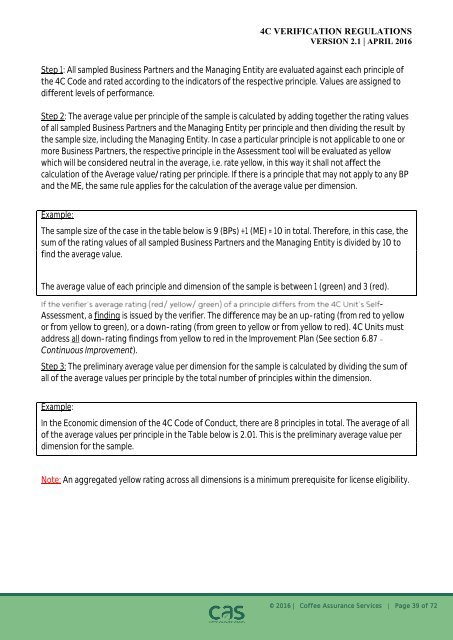VERIFICATION REGULATIONS
2byfvKv
2byfvKv
You also want an ePaper? Increase the reach of your titles
YUMPU automatically turns print PDFs into web optimized ePapers that Google loves.
4C <strong>VERIFICATION</strong> <strong>REGULATIONS</strong><br />
VERSION 2.1 | APRIL 2016<br />
Step 1: All sampled Business Partners and the Managing Entity are evaluated against each principle of<br />
the 4C Code and rated according to the indicators of the respective principle. Values are assigned to<br />
different levels of performance.<br />
Step 2: The average value per principle of the sample is calculated by adding together the rating values<br />
of all sampled Business Partners and the Managing Entity per principle and then dividing the result by<br />
the sample size, including the Managing Entity. In case a particular principle is not applicable to one or<br />
more Business Partners, the respective principle in the Assessment tool will be evaluated as yellow<br />
which will be considered neutral in the average, i.e. rate yellow, in this way it shall not affect the<br />
calculation of the Average value/rating per principle. If there is a principle that may not apply to any BP<br />
and the ME, the same rule applies for the calculation of the average value per dimension.<br />
Example:<br />
The sample size of the case in the table below is 9 (BPs) +1 (ME) = 10 in total. Therefore, in this case, the<br />
sum of the rating values of all sampled Business Partners and the Managing Entity is divided by 10 to<br />
find the average value.<br />
The average value of each principle and dimension of the sample is between 1 (green) and 3 (red).<br />
-<br />
Assessment, a finding is issued by the verifier. The difference may be an up-rating (from red to yellow<br />
or from yellow to green), or a down-rating (from green to yellow or from yellow to red). 4C Units must<br />
address all down-rating findings from yellow to red in the Improvement Plan (See section 6.87<br />
Continuous Improvement).<br />
Step 3: The preliminary average value per dimension for the sample is calculated by dividing the sum of<br />
all of the average values per principle by the total number of principles within the dimension.<br />
Example:<br />
In the Economic dimension of the 4C Code of Conduct, there are 8 principles in total. The average of all<br />
of the average values per principle in the Table below is 2.01. This is the preliminary average value per<br />
dimension for the sample.<br />
Note: An aggregated yellow rating across all dimensions is a minimum prerequisite for license eligibility.<br />
© 2016 | Coffee Assurance Services | Page 39 of 72


